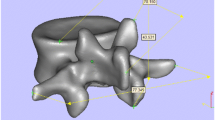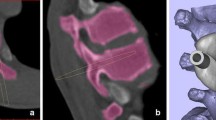Abstract
With the rapid increase in the use of thoracic pedicle screws in scoliosis, accurate and safe placement of screw within the pedicle is a crucial step during the scoliosis surgery. To make thoracic pedicle screw placement safer various techniques are used, Patient-specific drill template with pre-planned trajectory has been thought as a promising solution, it is critical to assess the efficacy, safety profile with this technique. In this paper, we develop and validate the accuracy and safety of thoracic transpedicular screw placement with patient-specific drill template technique in scoliosis. Patients with scoliosis requiring instrumentation were recruited. Volumetric CT scan was performed on each desired thoracic vertebra and a 3-D reconstruction model was generated from the CT scan data. The optimal screw size and orientation were determined and a drill template was designed with a surface that is the inverse of the posterior vertebral surface. The drill template and its corresponding vertebra were manufactured using rapid prototyping technique and tested for violations. The navigational template was sterilized and used intraoperatively to assist with the placement of thoracic screws. After surgery, the positions of the pedicle screws were evaluated using CT scan and graded for validation. This method showed its ability to customize the placement and the size of each pedicle screw based on the unique morphology of the thoracic vertebra. In all the cases, it was relatively very easy to manually place the drill template on the lamina of the vertebral body during the surgery. This method significantly reduces the operation time and radiation exposure for the members of the surgical team, making it a practical, simple and safe method. The potential use of such a navigational template to insert thoracic pedicle screws in scoliosis is promising. The use of surgical navigation system successfully reduced the perforation rate and insertion angle errors, demonstrating the clear advantage in safe and accurate pedicle screw placement of scoliosis surgery.



Similar content being viewed by others
References
Amiot LP, Poulin F (2004) Computed tomography-based navigation for hip, knee, and spine surgery. Clin Orthop Relat Res 421:77–86
Belmont PJ, Klemme WR, Dhawan A et al (2001) In vivo accuracy of thoracic pedicle screws. Spine 26:2340–2346
Belmont PJ Jr, Klemme WR, Robinson M et al (2002) Accuracy of thoracic pedicle screws in patients with and without coronal plane spinal deformities. Spine 27:1558–1566
Berry E, Cuppone M, Porada S et al (2005) Personalised image-based templates for intra-operative guidance. Proc Inst Mech Eng H 219:111–118
Bridwell KH, Lenke LG, Baldus C et al (1998) Major intraoperative neurologic deficits in pediatric and adult spinal deformity patients: incidence and etiology at one institution. Spine 23:324–331
Catan H, Buluc L, Anik Y et al (2007) Pedicle morphology of the thoracic spine in preadolescent idiopathic scoliosis: magnetic resonance supported analysis. Eur Spine J 16:1203–1208
Clin J, Aubin CÉ, Lalonde N et al (2011) A new method to include the gravitational forces in a finite element model of the scoliotic spine. Med Biol Eng Comput 49:967–977
Di Silvestre M, Parisini P, Lolli F et al (2007) Complications of thoracic pedicle screws in scoliosis treatment. Spine 32:1655–1661
Driscoll M, Aubin CE, Moreau A et al (2011) Biomechanical comparison of fusionless growth modulation corrective techniques in pediatric scoliosis. Med Biol Eng Comput 49(12):1437–1445
Foley KT, Simon DA, Rampersaud YA (2001) Virtual fluoroscopy: computer assisted fluoroscopic navigation. Spine 26:347–351
Gertzbein SD, Robbins SE (1990) Accuracy of pedicle screw placement in vivo. Spine 15:11–15
Gilbert TJ Jr, Winter RB (2005) Pedicle anatomy in a patient with severe early-onset scoliosis: can pedicle screws be safely inserted? J Spinal Disord Tech 18:360–363
Goffin J, Van Brussel K, Martens K et al (2001) Three-dimensional computed tomography-based, personalized drill guide for posterior cervical stabilization at C1-C2. Spine 26:1343–1347
Hamill C, Lenke L, Bridwell K et al (1996) The use of pedicle screw fixation to improve correction in the lumbar spine patients with idiopathic scoliosis: is it warranted? Spine 21:1241–1249
Hott JS, Theodore N, Klopfenstein JD et al (2004) Image guidance in spinal surgery for trauma: Iso-C 3D. Oper Tech Neurosurg 7:42–47
Kim KD, Patrick Johnson J, Bloch BSO et al (2001) Computer-assisted thoracic pedicle screw placement: an in vitro feasibility study. Spine 26:360–364
Kim YJ, Lenke LG, Bridwell KH et al (2004) Free hand pedicle screw placement in the thoracic spine: is it safe? Spine 29:333–342
Kim YJ, Lenke LG, Bridwell KH et al (2004) Free hand pedicle screw placement in the thoracic spine: is it safe? Spine 29:333–342
Kuklo TR, Lenke LG, O’Brien MF et al (2005) Accuracy and efficacy of thoracic pedicle screws in curve more than 90°. Spine 20:222–226
Lijenqvist UR, Link TM, Halm FH (2000) Morphometric analysis of thoracic and lumbar vertebrae in idiopathic scoliosis. Spine 25:1247–1253
Liljenqvist UR, Halm HF, Link TM (1997) Pedicle screw instrumentation of the thoracic spine in idiopathic scoliosis. Spine 19:2239–2245
Liljenqvist UR, Lepsien U, Hackeberg L et al (2002) Comparative analysis of pedicle idiopathic thoracic scoliosis. Eur Spine J 11:336–343
Lonner BS, Auerbach JD, Estreicher MB et al (2009) Thoracic pedicle screw instrumentation: the learning curve and evolution in technique in the treatment of adolescent idiopathic scoliosis. Spine 34:2158–2164
Lonstein JE, Denis F, Perra JH et al (1999) Complications associated with pedicle screws. J Bone Joint Surg Am 81:1519–1528
Lu S, Xu YQ, Zhang YZ et al (2009) A novel computer-assisted drill guide template for lumbar pedicle screw placement: a cadaveric and clinical study. Int J Med Robot Comput Assist Surg 5:184–191
Lu S, Xu YQ, Zhang YZ et al (2009) A novel computer-assisted drill guide template for placement of C2 laminar screws. Eur Spine J 18:1379–1385
Lu S, Xu YQ, Lu WW et al (2009) A novel patient-specific navigational template for cervical pedicle screw placement. Spine 34:E959–E964
Minor ME, Morrissey NJ, Peress R et al (2004) Endovascular treatment of an iatrogenic thoracic aortic injury after spinal instrumentation: case report. J Vasc Surg 39:893–896
Nolte LP, Beutler T (2004) Basic principles of CAOS. Injury 35:S–A6–16
O’Brien MF, Lenke LG, Mardjetko S et al (2000) Pedicle morphology in thoracic adolescent idiopathic scoliosis: is pedicle fixation an anatomically viable technique? Spine 25:2285–2293
O’Brien MF, Lenke LG, Mardjetko S et al (2000) Pedicle morphology in thoracic adolescent idiopathic scoliosis: is pedicle fixation an anatomically viable technique? Spine 25:228–293
Owen BD, Christensen GE, Reinhardt JM et al (2007) Rapid prototype patient-specific drill template for cervical pedicle screw placement. Comput Aided Surg 12:303–308
Parent S, Labelle H, Skalli W et al (2004) Thoracic pedicle morphometry in vertebrae from scoliotic spines. Spine 29:239–248
Radermacher K, Portheine F, Anton M et al (1998) Computer assisted orthopaedic surgery with image based individual templates. Clin Orthop Relat Res 354:28–38
Rajasekaran S, Vidyadhara S, Ramesh P et al (2007) Randomized clinical study to compare the accuracy of navigated and non-navigated thoracic pedicle screws in deformity correction surgeries. Spine 32:E56–E64
Sarlak AY, Tosun B, Atmaca H et al (2009) Evaluation of thoracic pedicle screw placement in adolescent idiopathic scoliosis. Eur Spine J 18:1892–1897
Smith RM, Pool RD, Butt WP et al (1991) The transverse plane deformity of structural scoliosis. Spine 16:1126–1129
Smorgick Y, Millgram MA, Anekstein Y et al (2005) Accuracy and safety of thoracic pedicle screw placement in spinal deformities. J Spinal Disord Tech 18:522–526
Suk SI, Lee CK, Kim WJ et al (1995) Segmental pedicle screw fixation in the treatment of thoracic idiopathic scoliosis. Spine 20:1399–1405
Suk S, Kim WJ, Lee SM et al (2001) Thoracic pedicle screw fixation in spinal deformities: are they really safe? Spine 26:2049–2057
Suk SI, Lee SM, Chung ER et al (2003) Determination of distal fusion level with segmental pedicle screw fixation in single thoracic idiopathic scoliosis. Spine 28:484–491
West JL, Ogilvie JW, Bradford DS (1991) Complications of the variable screw plate pedicle screw fixation. Spine 16:576–579
Wu H, Ronsky JL, Cheriet F et al (2010) Prediction of scoliosis progression with serial three-dimensional spinal curves and the artificial progression surface technique. Med Biol Eng Comput 48:1065–1075
Acknowledgments
The authors would like to thank Dr. You-hua Cheng for his assistance with the CT data collection. This work was supported by Yunnan Natural Science Foundation (2010ZC183 and 2011CA015).
Author information
Authors and Affiliations
Corresponding author
Rights and permissions
About this article
Cite this article
Lu, S., Zhang, Y.Z., Wang, Z. et al. Accuracy and efficacy of thoracic pedicle screws in scoliosis with patient-specific drill template. Med Biol Eng Comput 50, 751–758 (2012). https://doi.org/10.1007/s11517-012-0900-1
Received:
Accepted:
Published:
Issue Date:
DOI: https://doi.org/10.1007/s11517-012-0900-1




